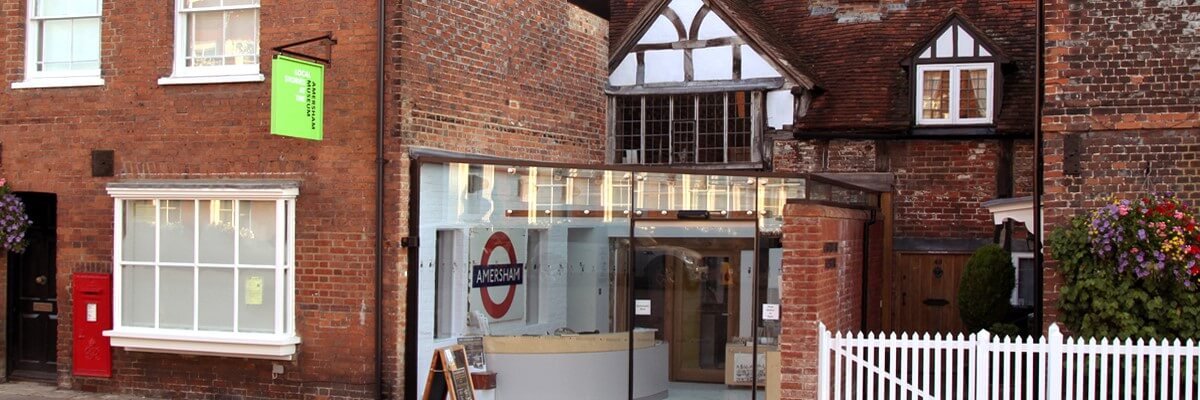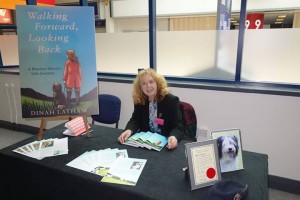 Dinah Latham is the author of Walking Forward, Looking Back, her reflections on her life as a district nurse whilst walking around Amersham with her close companion Harriet, the dog. In this photo she is signing copies of her book at the Queen’s Nursing Institute on 29th March 2015. Dinah has very kindly written her memories of her 1940s childhood for us.
Dinah Latham is the author of Walking Forward, Looking Back, her reflections on her life as a district nurse whilst walking around Amersham with her close companion Harriet, the dog. In this photo she is signing copies of her book at the Queen’s Nursing Institute on 29th March 2015. Dinah has very kindly written her memories of her 1940s childhood for us.

My father was a motorbike despatch rider in WWII. He had signed up the day war broke out despite being in a reserved occupation and wouldn’t have been ‘called up’ until later in the war. He was invalided out of the army following Dunkirk. I then arrived, somewhat unexpectedly I’m told, as a war baby in 1942 to take my position in the family as the third daughter of Roland and Eleanor Hatchett living in Kings Road, Chalfont St Giles. My memories are scattered and don’t fit into any sort of pattern and I have to be careful to make sure they are memories rather than stories I’ve been told.
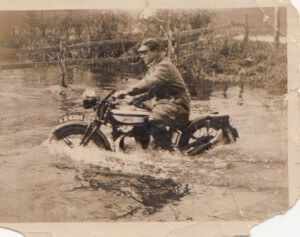
We kept chickens in a small orchard that formed part of our garden and the eggs collected were stored in a very large glass jar in something very slimy which I think was something called ‘isinglass’. This substance preserved the eggs and it was my job to put my hands into the slime when asked to retrieve some for lunch … I hated doing it! This memory is mixed with a very strong smell that used to emanate from the kitchen most days when all the scraps of anything … potato peelings, vegetable stalks and such like were being boiled up on the range to feed the said chickens.
There were always dead rabbits and pheasants hanging in the walk-in larder that my father brought home … he seemed to go shooting often and my mother was always plucking or skinning something! We had a high shelf that went all around the kitchen with bottled fruit from every season displayed there. Through the summer we would always be picking fruit for pudding and storing; in winter Mum would take down one of the jars of bottled fruit for pudding each Sunday lunchtime… very often apples from our tiny orchard.
The feeling of never wasting anything prevailed … making use of everything; not simply foodstuffs but pieces of material always made into patchwork before using them for making clothes or bedclothes. Blanket stich was one of the first stiches I learned to do and then a French seam for sheets as they were turned sides to middle to make them last. I remember clothes coupons being saved …. also learning to knit and using darning wool to knit with because it could be purchased without those coupons. The problem was the colours were so dreary … black, brown and dark grey are all I remember and the wool was thin so took lots of knitting and was very scratchy to wear. Sitting with a wooden ‘mushroom’ darning socks is an activity not seen now but my mother seemed to be undertaking that task very many evenings in front of the coal fire. Everything was reinforced to improve its longevity doubling up on wool thickness when knitting heels, toes and elbows. That coal fire had a boiler at the back of it – the water being heated when the fire was alight … our weekly baths were taken when the fire had been going for sufficient time to fill the bath … us three children bathing one after the other (me last!) in the same water with an extra jug of hot water emptied in before my ablutions if the fire hadn’t gone out!
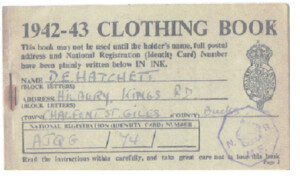
Of course there was no central heating and underclothes were kept under the bedclothes overnight so they were warm to put on in the morning while still in bed …. and the vest was always still snuggly inside the dreaded liberty bodice for warmth … those rubber buttons on the offending article were a real fiddle.
To return to sewing for a moment … the first item all of us had to make in our sewing class at school was a ration book cover … it brought back many memories when I went through my mother’s belongings after she died and I found it … still with ration books and clothes coupons in it! There were no sweet coupons in there but I was reminded of the first time my mother gave me some three penny pieces to buy as a celebration when rationing came off sweets and me being unable to comprehend how the shop keeper would let me have any if I didn’t produce any coupons … so much were they a part of my childhood.
Talking of school, the playground at school had a long air raid shelter down the centre of the playground separating the boys from the girls …. no longer in use after the end of the war but still there and we were forbidden to go in it.
I can’t remember the year or my age but there was a time when we ourselves were happily ‘invaded’ by Polish children from the Hodgemoor Camp. Each of us was ‘given’ a child about our own age who became our personal responsibility. They spoke no English and sat next to us on the bench seats attached to our desks and copied everything we did … we held hands with our protégé for most of the day, leading them over to lunch, often teaching them words as you would a child, pointing to the cutlery and saying ‘spoon’ and them repeating the word. Assembly was always conducted by the headmaster Mr Groom and I recall songs such as ‘Underneath the spreading Chestnut Tree’ and ‘Knees and Toes’ at this time seeming to play a part in integrating us all together in actions. There were always a lot of them as I remember it; doubling numbers everywhere; crowded classrooms, longer dinner queues … I have no memory at all of how long they were with us or where they went but what has stayed with me is just how quickly they learned to speak English.
We had a car in our family … one of the very few in the road … due to my father needing it for work I think. We had petrol coupons that were kept on the mantelpiece … a very precious commodity I recall.
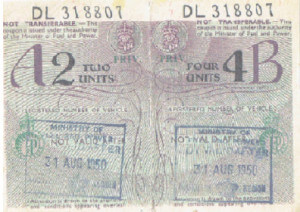
We lived in Kings Road in Chalfont St Giles, the top of which was very near Vache Army Camp. The army lorries and other army traffic travelled noisily up and down the road frequently; they were part of the landscape. As I grew older I remember being told the story by my father of an accident involving soldiers that happened in the road. Of course there were no street lights during the war and also cars had attachments that covered their lights at night, directing them down onto the ground right in front of the car. He told the story of once driving into some drunk soldiers walking in the middle of the road near our house as they were heading back to Vache Camp late at night.
I also remember my mother telling me how because we were one of the few houses in the road which had a telephone, she had been contacted by the war office and asked to go and inform a friend, who lived further up the road, that her husband, an air force pilot, was ‘missing believed killed’; he never returned. She had moved out from London with her daughter and rented a property with her young child rather than evacuate her daughter out to the country on her own. I gather it was at this time that my mother found she was pregnant with me … and this friend asked to be my godmother because now she would never have any more children of her own. She became a very special ‘Auntie’ whom I loved dearly because she was such a close friend of my mother’s.
I remember going home with a friend for tea from school and she lived in one of the ‘prefabs’ in Amersham ….on the main Amersham Road on the A413 on the right coming from Chalfont St Giles towards Amersham …. before Stanley Hill. They were meant to be emergency housing during the war but they existed for many years afterwards and inhabitants really liked them. In later years I remember coming over on the bus to Amersham to go to the cinema, a big event …. it was sort of where Iceland is now I think.
I think I remember VE day … there was a long table covered with a Union Jack and there was lots of lovely food on it …. party food with bright red icing on everything.

